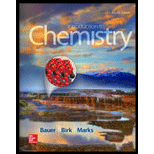
Concept explainers
How do acids and bases differ from other substances?
Interpretation:
The identification of acids and bases from other substances.
Concept Introduction:
Acids are chemical substances that are capable of donating hydrogen atoms or of accepting an electron. Bases are chemical substances that are capable of accepting hydrogen atoms or donating an electron.
Explanation of Solution
Acids were found to be sour in taste, burning sensation along with being sticky to touch. Acids are substances that produce hydrogen ions
While bases were found to be bitter in taste, slippery to touch. Bases produce hydroxide ions
Therefore, acids are known to be proton donors which are sour in taste, have a burning sensation and feel sticky to touch. While bases are known to be proton acceptors that have a bitter taste and feel slippery to touch.
Want to see more full solutions like this?
Chapter 13 Solutions
Introduction to Chemistry
- According to the Arrhenius theory of acids and bases, how do you recognize an acid and a base?arrow_forward. The following figures are molecular-level representations of acid solutions. Label each as a strong acid or a weak acid.arrow_forwardPerchloric acid behaves as an acid, even when it is dissolved in sulfuric acid. (a) Write a balanced equation showing how perchloric and can transfer a proton to sulfuric acid (b) Draw a Lewis electron dot structure for sulfuric acid How can sulfuric acid function as a base?arrow_forward
 Living By Chemistry: First Edition TextbookChemistryISBN:9781559539418Author:Angelica StacyPublisher:MAC HIGHER
Living By Chemistry: First Edition TextbookChemistryISBN:9781559539418Author:Angelica StacyPublisher:MAC HIGHER Introductory Chemistry: An Active Learning Approa...ChemistryISBN:9781305079250Author:Mark S. Cracolice, Ed PetersPublisher:Cengage Learning
Introductory Chemistry: An Active Learning Approa...ChemistryISBN:9781305079250Author:Mark S. Cracolice, Ed PetersPublisher:Cengage Learning- Chemistry: Matter and ChangeChemistryISBN:9780078746376Author:Dinah Zike, Laurel Dingrando, Nicholas Hainen, Cheryl WistromPublisher:Glencoe/McGraw-Hill School Pub Co
 Chemistry for Today: General, Organic, and Bioche...ChemistryISBN:9781305960060Author:Spencer L. Seager, Michael R. Slabaugh, Maren S. HansenPublisher:Cengage Learning
Chemistry for Today: General, Organic, and Bioche...ChemistryISBN:9781305960060Author:Spencer L. Seager, Michael R. Slabaugh, Maren S. HansenPublisher:Cengage Learning General Chemistry - Standalone book (MindTap Cour...ChemistryISBN:9781305580343Author:Steven D. Gammon, Ebbing, Darrell Ebbing, Steven D., Darrell; Gammon, Darrell Ebbing; Steven D. Gammon, Darrell D.; Gammon, Ebbing; Steven D. Gammon; DarrellPublisher:Cengage Learning
General Chemistry - Standalone book (MindTap Cour...ChemistryISBN:9781305580343Author:Steven D. Gammon, Ebbing, Darrell Ebbing, Steven D., Darrell; Gammon, Darrell Ebbing; Steven D. Gammon, Darrell D.; Gammon, Ebbing; Steven D. Gammon; DarrellPublisher:Cengage Learning





